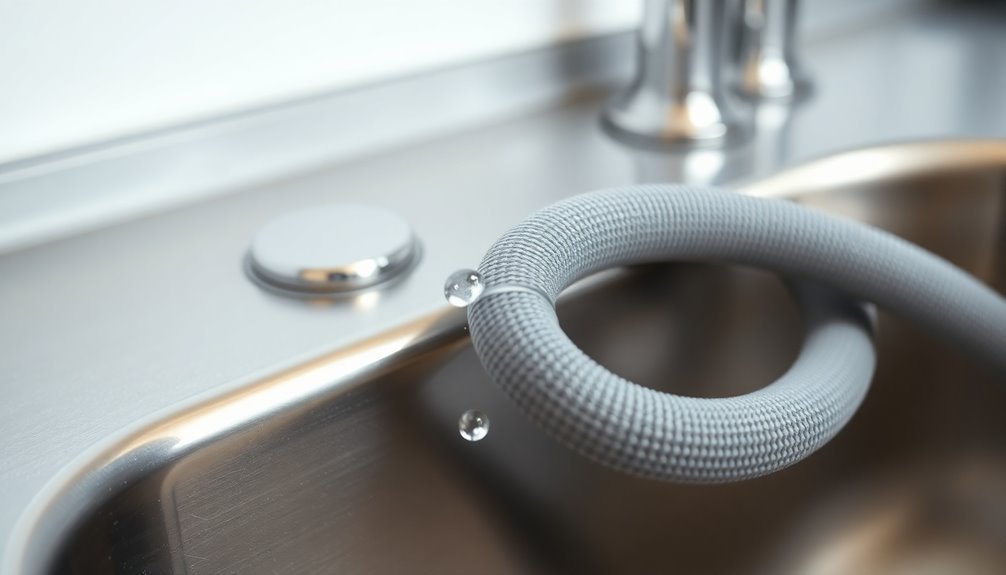To connect your dishwasher drain hose to the sink, gather a 7/8-inch drain hose, hose clamps, and a utility knife. If using an air gap with a garbage disposal, attach the hose to the air gap, then to the disposal. For an air gap without a disposal, secure the hose above the sink drain. If opting for a high loop, create an inverted U-shape at least 32 inches high. Keep going for more tips on securing your setup.
Key Takeaways
- Measure and cut the dishwasher drain hose to an appropriate length for the connection to the sink or garbage disposal.
- Securely attach the hose to the air gap or sink drain using hose clamps to prevent leaks.
- Ensure the air gap is installed at least 2 inches above the sink's flood level for proper drainage.
- If using a high loop, create an inverted U-shape with the hose at least 32 inches high to prevent kinks.
- After installation, check for leaks by running the dishwasher and monitoring drainage performance during initial cycles.
What You'll Need
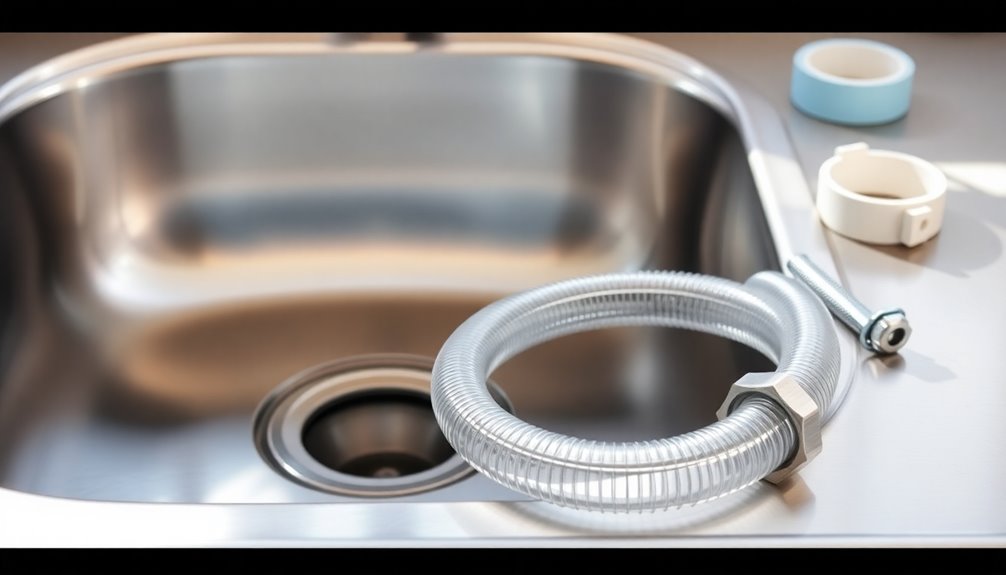
Before you plunge into connecting your dishwasher drain hose, gather a few essential tools and materials.
You'll need a 7/8-inch dishwasher drain hose, which fits snugly into both the drain pipe and the air gap inlet.
Hose clamps are vital for securing the connections and preventing leaks, so make sure to have a few on hand.
A utility knife and screwdrivers will help you trim any excess hose length and tighten the clamps properly.
Depending on your setup, you may require a Y-branch drain tailpiece or a garbage disposal drain adapter for compatibility.
Finally, always check local plumbing codes to confirm whether an air gap or high loop configuration is necessary for your installation.
Drain Connection With Air Gap and Garbage Disposal
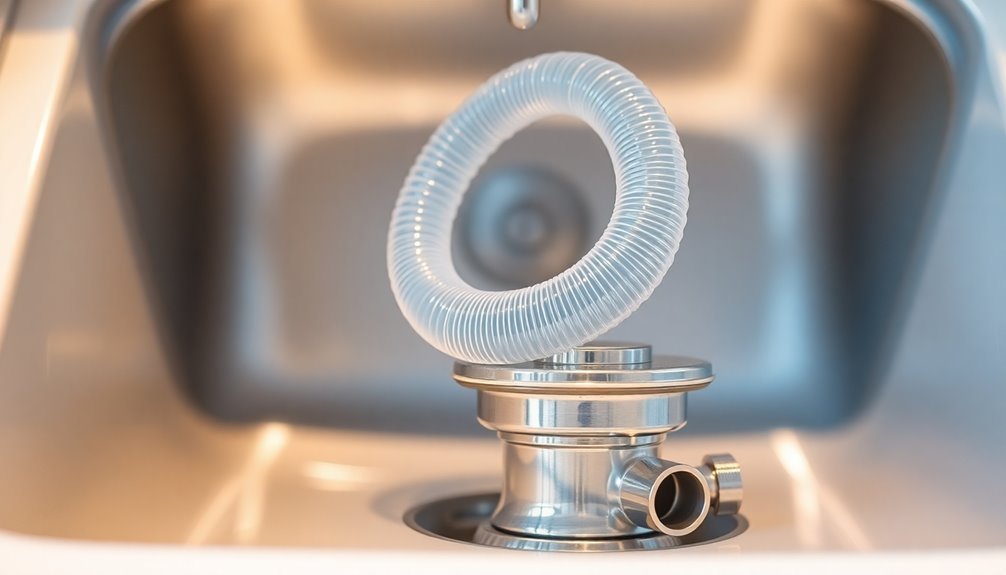
Now that you have your tools ready, it's time to connect the dishwasher drain hose using an air gap and a garbage disposal.
First, cut the drain hose to the appropriate length so it reaches the smaller tailpiece of the air gap securely. Use a hose clamp to attach the hose to the air gap, ensuring a tight seal to prevent leaks.
Next, connect the larger end of the air gap to the garbage disposal with a 7/8-inch rubber hose, checking for kinks that could block drainage. If the hose seems too long, trim it as necessary.
Always verify your local plumbing codes to confirm that installing an air gap is required for your dishwasher setup to prevent any backflow issues.
Drain Connection With Air Gap (But No Garbage Disposal)
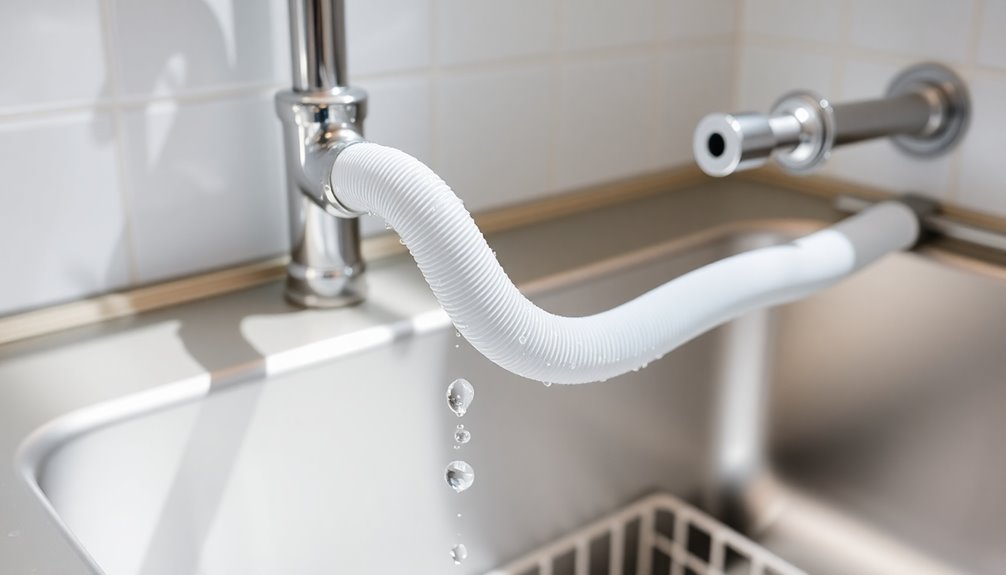
To connect your dishwasher drain hose to a sink that doesn't have a garbage disposal, start by measuring and cutting the drain hose to the right length for the air gap's inlet.
Use a utility knife for a clean cut, then securely attach the 7/8-inch drain hose to the air gap using a hose clamp to prevent leaks.
Make sure the air gap outlet directs towards the sink drain, allowing proper drainage of wastewater.
It's essential that the air gap is installed at least 2 inches above the flood level of the sink, effectively preventing backflow of contaminated water.
Finally, check local plumbing codes to verify your installation meets regulations regarding air gaps for dishwasher drainage in your area.
Drain Connection Using High Loop to Garbage Disposal
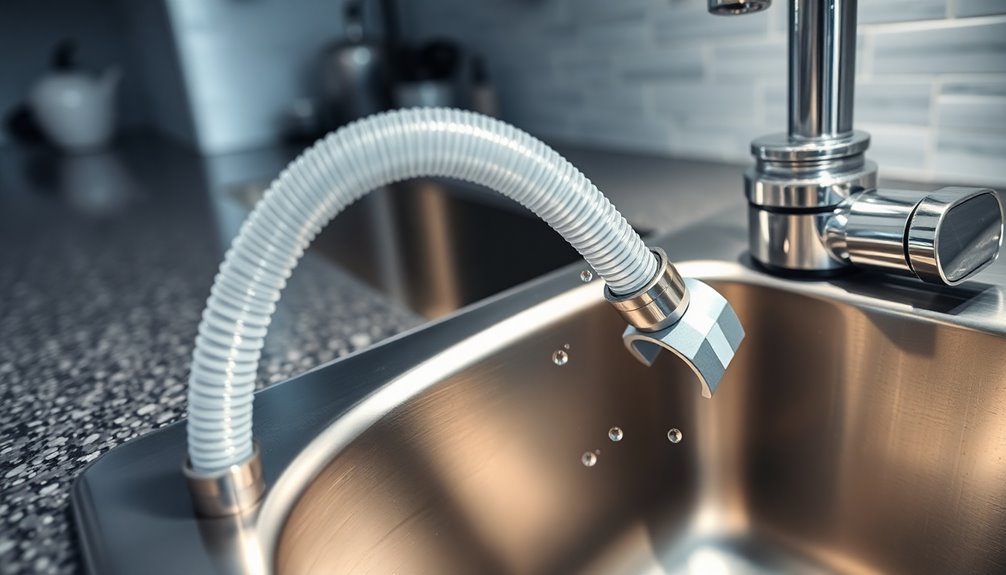
When connecting your dishwasher drain hose to the garbage disposal using a high loop, it's essential to check your local building codes first.
Confirm the hose is configured properly to create that necessary loop and prevent any kinks that could hinder drainage.
This attention to detail will help guarantee your dishwasher drains efficiently.
Verify Local Building Codes
Have you checked your local building codes before installing a high loop drain connection for your dishwasher? It's essential to verify local building codes to guarantee you meet plumbing requirements. Most plumbing codes mandate that the drain hose must be at least 32 inches above the floor to prevent backflow contamination. Some areas even require an air gap instead of a high loop for added protection.
| Requirement | Description |
|---|---|
| Drain Hose Height | Must be at least 32 inches above floor |
| Air Gap Requirement | May be necessary in some jurisdictions |
| Consult Local Codes | Verify specific materials and methods |
Ignoring these regulations can lead to plumbing violations, fines, and complications during home inspections.
Proper Hose Configuration
Connecting your dishwasher drain hose using a high loop configuration is crucial for effective drainage and preventing backflow. To achieve this, pull some extra hose from behind the dishwasher and form an inverted U-shape that reaches at least 32 inches high under the sink.
Secure this high loop with plumbers tape or zip ties to guarantee it doesn't fall or kink, which could disrupt the drain line. Then, connect the dishwasher drain hose directly to the garbage disposal or sink drain, making sure the connection is tight to avoid leaks.
Always check local building codes to confirm this proper hose configuration complies with regulations. Finally, run the dishwasher to verify proper drainage and inspect for any leaks or obstructions.
Check for Kinks
After securing the drain hose in a high loop, it's important to check for any kinks that could hinder water flow. Kinks can obstruct the connections and lead to drainage issues, so take a moment to inspect your setup.
Here's what to look for:
- Verify the drain hose is pulled taut and free of bends.
- Examine the hose under the sink for any twists or kinks.
- Check both connections at the garbage disposal and dishwasher for tightness.
- If you spot any kinks, adjust the hose or consider replacing it.
Drain Connection Using High Loop Directly to Drain

Connecting your dishwasher drain hose directly to the drain using a high loop offers several benefits, including preventing backflow and ensuring proper drainage.
To get started, you'll need to follow specific installation steps to create that necessary high loop.
Let's explore how this setup can enhance your dishwasher's performance and keep your kitchen clean.
High Loop Benefits
When you elevate the dishwasher drain hose using the high loop method, you effectively prevent wastewater from flowing back into the appliance.
This configuration offers several benefits:
- Prevents Backflow: The high loop design stops wastewater from returning to the dishwasher.
- Space-Saving: You can avoid the need for an air gap, making it ideal for compact kitchens.
- Regulatory Compliance: Many local building codes accept the high loop as a compliant alternative to air gaps.
- Improved Drainage: Properly installed, it uses gravity for effective drainage, reducing the risk of clogs affecting performance.
Installation Steps Explained
To successfully install your dishwasher drain hose using the high loop method, you'll need to make certain the hose creates an inverted U-shape that reaches at least 32 inches high under your sink. Secure the high loop with plumber's tape or zip ties to prevent it from falling. Next, connect the hose directly to your garbage disposal or sink drain using a hose clamp for a tight fit.
Here's a quick reference table for your installation:
| Step | Action | Tips |
|---|---|---|
| 1 | Pull out the hose | Make certain it's long enough |
| 2 | Secure the high loop | Use tape or zip ties |
| 3 | Connect to disposal or drain | Use a hose clamp |
| 4 | Check for leaks and clogs | Adjust hose if needed |
Once done, turn on the water supply and check for leaks.
Final Checks and Testing

Once you've connected the dishwasher drain hose, it's important to perform final checks and testing to guarantee everything is functioning properly.
Follow these steps to verify your installation is secure:
- Turn on the water supply and start the dishwasher to check for any leaks at all connections.
- Confirm all hose clamps are tightly secured to prevent potential leaks during operation.
- Inspect the air gap or high loop installation to validate the hose is properly positioned for ideal drainage without kinks or blockages.
- Monitor the dishwasher's drainage performance during the first few cycles to ascertain water flows freely and there are no backup issues.
If you spot any leaks or drainage problems, be ready to disconnect the hose and reevaluate your connections.
Frequently Asked Questions
Can a Dishwasher and a Sink Share the Same Drain?
Yes, a dishwasher and a sink can share the same drain, and it's quite common.
You'll need to guarantee proper installation to avoid issues, like backflow. Typically, a Y-branch drain tailpiece is used to connect both units.
Remember to follow local plumbing codes that might require an air gap or high loop to prevent contamination.
Secure connections with hose clamps are also essential to prevent leaks and maintain hygiene in your kitchen.
How to Attach Dishwasher Hose to Faucet?
To attach your dishwasher hose to the faucet, start by ensuring you have the right adapter if the sizes differ.
Use a 7/8-inch drain hose for proper drainage and cut it to the needed length if required.
Secure the connection with a hose clamp, tightening it enough to prevent leaks.
If there's an air gap, connect the hose to its inlet first, then route the outlet to the sink drain.
Always check local plumbing codes.
How Should a Dishwasher Drain Hose Be Positioned?
You mightn't realize it, but the positioning of your dishwasher drain hose is essential for its performance.
To prevent backflow, you need to guarantee it forms a high loop, sitting at least 32 inches above the floor. If you're using an air gap, connect it properly to the sink or garbage disposal.
Remember to secure all connections with clamps, and keep the hose straight and free of kinks for ideal drainage.
How Should Dishwasher Hose Loop Under Sink?
To guarantee proper drainage, you should position the dishwasher hose in a high loop under the sink. Elevate the hose at least 32 inches above the floor and secure it to the underside of the sink to prevent sagging.
This prevents backflow and clogs. Regularly check for kinks or blockages, as these can disrupt drainage.
Always follow local plumbing codes to maintain compliance and guarantee your system works efficiently.
Conclusion
As you connect the dishwasher drain hose, think of it as weaving a tapestry of water flow. Each thread, from the air gap to the high loop, plays an essential role in a harmonious kitchen symphony. Just like a gardener nurtures their plants, make sure every connection is secure. When you finish, test your creation, and watch the water dance through your newly crafted masterpiece, knowing you've transformed a simple task into a seamless part of your home's rhythm.
